20872 ACE Language (Foundation) Language of Texts
You also want an ePaper? Increase the reach of your titles
YUMPU automatically turns print PDFs into web optimized ePapers that Google loves.
Your partner in education<br />
FOUNDATION<br />
ENGLISH<br />
LANGUAGE:<br />
TEXT STRUCTURE AND ORGANISATION<br />
<strong>Language</strong> <strong>of</strong> texts<br />
Understand that some language in written<br />
texts is unlike everyday spoken language<br />
(<strong>ACE</strong>LA1431)<br />
Australian Primary Publisher<br />
<strong>of</strong> the Year 2015 and 2016
Australian Curriculum English – <strong>Language</strong>:<br />
Text structure and organisation (<strong>Foundation</strong>)<br />
Foreword<br />
Australian Curriculum English – <strong>Language</strong>: Text structure and organisation (<strong>Foundation</strong>) is one in a series <strong>of</strong><br />
seven teacher resource books that support teaching and learning activities in Australian Curriculum English. The books<br />
focus on the sub-strand <strong>of</strong> Text structure and organisation within the <strong>Language</strong> strand <strong>of</strong> the national English curriculum.<br />
The resource books include theoretical background information, activities to develop the content descriptions, blackline<br />
masters, resource sheets and assessment checklists, along with interrelated links to other English strands and sub-strands.<br />
Titles in this series are:<br />
• Australian Curriculum English – <strong>Language</strong>: Text structure and organisation (<strong>Foundation</strong>)<br />
• Australian Curriculum English – <strong>Language</strong>: Text structure and organisation (Year 1)<br />
• Australian Curriculum English – <strong>Language</strong>: Text structure and organisation (Year 2)<br />
• Australian Curriculum English – <strong>Language</strong>: Text structure and organisation (Year 3)<br />
• Australian Curriculum English – <strong>Language</strong>: Text structure and organisation (Year 4)<br />
• Australian Curriculum English – <strong>Language</strong>: Text structure and organisation (Year 5)<br />
• Australian Curriculum English – <strong>Language</strong>: Text structure and organisation (Year 6)<br />
Contents<br />
Format <strong>of</strong> this book ............................................. iv – v<br />
<strong>Language</strong>: Text structure and organisation .......... 2–67<br />
Understand that texts can take many forms, can be very<br />
short (for example an exit sign) or quite long (for example<br />
an information book or film) and that stories and<br />
informative texts have different purposes (<strong>ACE</strong>LA1430)<br />
© Australian Curriculum: Assessment and Reporting Authority 2012<br />
–Teacher information ........................................................... 2<br />
–Activities to develop the content description ..................... 3<br />
–Resource sheets ........................................................... 4–21<br />
–Assessment checklist ....................................................... 22<br />
–Interrelated English links .................................................. 33<br />
– Modes, capabilities and priorities covered by<br />
the activities in this content description .......................... 33<br />
Understand that some language in written texts is<br />
unlike everyday language (<strong>ACE</strong>LA1431)<br />
© Australian Curriculum: Assessment and Reporting Authority 2012<br />
–Teacher information ......................................................... 24<br />
–Activities to develop the content description ................... 25<br />
–Resource sheets ......................................................... 26–35<br />
–Assessment checklist ....................................................... 36<br />
–Interrelated English links .................................................. 37<br />
– Modes, capabilities and priorities covered by<br />
the activities in this content description .......................... 38<br />
Understand that punctuation is a feature <strong>of</strong> written text<br />
different from letters; recognises how capital letters<br />
are used for names, and that capital letters and full stops<br />
signal the beginning and end <strong>of</strong> sentences (<strong>ACE</strong>LA1432)<br />
© Australian Curriculum: Assessment and Reporting Authority 2012<br />
–Teacher information ......................................................... 38<br />
–Activities to develop the content description ................... 39<br />
–Resource sheets ......................................................... 40–47<br />
–Assessment checklist ....................................................... 48<br />
–Interrelated English links .................................................. 49<br />
– Modes, capabilities and priorities covered by<br />
the activities in this content description .......................... 49<br />
Understand concepts about print and screen, including how<br />
books, film and simple digital texts work, and know some<br />
features <strong>of</strong> print, for example directionality (<strong>ACE</strong>LA1433)<br />
© Australian Curriculum: Assessment and Reporting Authority 2012<br />
–Teacher information ......................................................... 50<br />
–Activities to develop the content description ................... 51<br />
–Resource sheets ......................................................... 52–65<br />
–Assessment checklist ....................................................... 66<br />
–Interrelated English links .................................................. 67<br />
– Modes, capabilities and priorities covered by<br />
the activities in this content description .......................... 67<br />
R.I.C. Publications ® www.ricpublications.com.au Australian Curriculum English – <strong>Language</strong>: Text structure and organisation (<strong>Foundation</strong>)<br />
iii
Format <strong>of</strong> the book<br />
This teacher resource book includes supporting materials for teaching and learning in the sub-strand <strong>of</strong> Text structure and<br />
organisation within the strand <strong>of</strong> <strong>Language</strong> in Australian Curriculum English. All content descriptions in the sub-strand<br />
have been included, as well as teaching points based on the Curriculum’s elaborations.<br />
While the book focuses on the sub-strand <strong>of</strong> Text structure and organisation, activities and interrelated links to other<br />
strands and sub-strands have been incorporated.<br />
Each section supports a specific content description and follows a consistent format, containing the following information<br />
over several pages:<br />
• activities to develop the content descriptions • resource sheets • interrelated English links<br />
• assessment checklist • a table showing the modes, capabilities and priorities covered by the activities<br />
The length <strong>of</strong> each content description section varies.<br />
Teacher information includes background information relating to the content description, as well as<br />
related terms and desirable student vocabulary and other useful details which may assist the teacher.<br />
Related terms includes vocabulary<br />
associated with the content description.<br />
Many <strong>of</strong> these relate to the glossary in the<br />
back <strong>of</strong> the <strong>of</strong>ficial Australian Curriculum<br />
English document; additional related terms<br />
may also have been added.<br />
Student vocabulary includes words which<br />
the teacher would use—and expect the<br />
students to learn, understand and use—<br />
during English lessons.<br />
Further resources by R.I.C. Publications<br />
or other publishers or authors are included<br />
where appropriate.<br />
?<br />
T<br />
E<br />
What this means<br />
provides a general<br />
explanation <strong>of</strong> the<br />
content description.<br />
Teaching points<br />
provides a list <strong>of</strong> the<br />
main teaching points<br />
relating to the content<br />
description.<br />
Elaborations are a<br />
list <strong>of</strong> elaborations<br />
based on those in the<br />
content description.<br />
Activities to develop the content<br />
description includes descriptions or<br />
instructions for activities or games relating<br />
to the content descriptions or elaborations.<br />
Some activities are supported by blackline<br />
masters or resource sheets. Where<br />
applicable, these will be stated for easy<br />
reference.<br />
Australian Curriculum English – <strong>Language</strong>: Text structure and organisation (<strong>Foundation</strong>) www.ricpublications.com.au R.I.C. Publications ®<br />
iv
Format <strong>of</strong> the book<br />
Resource sheets are<br />
provided to support<br />
teaching and learning<br />
activities for each content<br />
description. These include<br />
sheets for individual use,<br />
games, charts and other<br />
materials which the<br />
teacher might find useful<br />
to use or display in the<br />
classroom.<br />
Each section has a<br />
checklist which teachers<br />
may find useful as a<br />
place to keep a record <strong>of</strong><br />
their observations <strong>of</strong> the<br />
activities to develop the<br />
content descriptions.<br />
Interrelated English<br />
links lists other links<br />
covered within the<br />
<strong>Language</strong> strand,<br />
Literature strand and<br />
Literacy strand <strong>of</strong> English<br />
that are incorporated in<br />
the activities provided<br />
with the content<br />
description. While the<br />
book’s approach focuses<br />
on the Text structure<br />
and organisation substrand,<br />
the links show<br />
the integration across the<br />
three strands.<br />
A table showing the<br />
<strong>Language</strong> modes,<br />
General capabilities<br />
and Cross-curriculum<br />
priorities covered by the<br />
activities in each content<br />
description is provided.<br />
R.I.C. Publications ® www.ricpublications.com.au Australian Curriculum English – <strong>Language</strong>: Text structure and organisation (<strong>Foundation</strong>)<br />
v
Text structure<br />
and organisation<br />
Understand that some language in written texts is unlike everyday language (<strong>ACE</strong>LA1431)<br />
© Australian Curriculum: Assessment and Reporting Authority 2012<br />
Related terms<br />
<strong>Texts</strong><br />
Written, spoken or multimodal forms <strong>of</strong><br />
communications for a range <strong>of</strong> purposes<br />
<strong>Language</strong><br />
Spoken or written forms <strong>of</strong> human<br />
communication which use words in a<br />
structured and conventional way<br />
Everyday language<br />
Daily language used with family, friends and<br />
colleagues in relaxed situations. Less formal<br />
language than written language.<br />
written<br />
texts<br />
spoken<br />
language<br />
word<br />
spaces<br />
letters<br />
Student vocabulary<br />
spell<br />
write<br />
letter<br />
sound<br />
sentence<br />
picture<br />
illustration<br />
What this means<br />
Teacher information<br />
• Students will learn that spoken language is different from written language.<br />
• Students will realise that when writing a text, rules must be followed to help others<br />
understand it.<br />
• Students will understand that:<br />
~ words are letters grouped closely together<br />
~ there are spaces between words<br />
~ texts may include both print and illustrations or pictures<br />
~ we all have to spell words the same way so that everyone can understand them.<br />
Teaching points<br />
• Students will learn that spoken language can be written down.<br />
• Students will be exposed to the use <strong>of</strong> correct sentence structure in many different<br />
situations; for example, during shared reading <strong>of</strong> big books.<br />
• Students will learn that individual sounds (and therefore letters) are used to make<br />
up words, and that the sounds/letters are written side to side to make a word.<br />
• Students will become aware <strong>of</strong> the spaces between words and that spaces indicate<br />
the beginnings and endings <strong>of</strong> words.<br />
• Students will become aware <strong>of</strong> the difference between print and illustrations/<br />
pictures and that illustrations/pictures support print.<br />
• Students will learn that correct spelling is necessary if others are to understand<br />
written text.<br />
• Students will become aware that written text has meaning which does not change<br />
(as oral text may).<br />
Elaboration<br />
E1. A text written in Standard Australian English has conventions including<br />
words, spaces between words, page layout and consistent spelling that<br />
make it easier for others to understand it when the speaker/writer is not<br />
there to explain it.<br />
Further resources<br />
• Early literacy games – Play to learn<br />
by Christine Gallacher and Margaret Grubb R.I.C. Publications<br />
• Essential Phonics – Initial Sounds<br />
by Rosemary Allen R.I.C. Publications<br />
Australian Curriculum English – <strong>Language</strong>: Text structure and organisation (<strong>Foundation</strong>) www.ricpublications.com.au R.I.C. Publications ®<br />
24
Text structure<br />
and organisation<br />
Understand that some language in written texts is unlike<br />
everyday language (<strong>ACE</strong>LA1431)<br />
© Australian Curriculum: Assessment and Reporting Authority 2012<br />
Activities to<br />
develop the content<br />
description<br />
E1. A text written in Standard Australian English has conventions including words, spaces between words,<br />
page layout and consistent spelling that make it easier for others to understand it when the speaker/writer<br />
is not there to explain it.<br />
• Reinforce the connection between spoken and written word by recording individual word or sentence answers to questions, daily class activities, oral<br />
show and tell or news presentations or similar. In a large big book, on the whiteboard or in digital form, these may be reviewed later by the class, small<br />
groups, pairs or individuals as a ‘reading’ activity.<br />
• Highlight the difference between the words and the page by recording words or sentences in different colours. Consistently use the correct language<br />
while scribing or modelling writing. Include ‘word’, ‘space’, ‘capital letter’, ‘full stop’ and ‘spelling’.<br />
• Use letters on cards, Unifi x letter cubes (consonants and vowels only if possible) or Scrabble<br />
tiles to demonstrate how letters are joined together to make words such as student names. Refer<br />
to pages 26 to 29 for an example <strong>of</strong> some letter cards.<br />
• After modelled writing <strong>of</strong> a simple text, read it with the students inserting an action such as a clap<br />
or breath whenever a space occurs between words. Later, when students begin to learn formal<br />
handwriting, they may be asked to put a ‘fi nger space’ by placing a fi nger between words. This<br />
may be introduced by asking the students to hold up their ‘pointer fi nger’ when a space is needed<br />
rather than using a clap. When creating simple sentences, such as those in a class weather chart,<br />
include blank cards to use as spaces to reinforce the concept <strong>of</strong> spaces being inserted between<br />
words (and to show where the beginnings and endings <strong>of</strong> words occur).<br />
• Write each word <strong>of</strong> a scribed text on an A4 sheet <strong>of</strong> paper or cardboard for selected children to hold in front <strong>of</strong> them while they stand in a straight line<br />
as others ‘read’. Ensure they leave a gap between them to represent the spaces between words (or have a blank sheet <strong>of</strong> cardboard for other children to<br />
hold to indicate spaces). Pages 32 and 33 give examples.<br />
• For those students who are ready, have them copy a simple sentence by typing it on a computer. The space bar will need to be used to insert spaces<br />
between words. If desired, stick a label to the space bar which says ‘space’ or glue on a strip <strong>of</strong> coloured paper to assist identifi cation.<br />
• Cut up the words <strong>of</strong> simple sentences, jumble them and have the students match them to a completed copy <strong>of</strong> the sentence to show that each word is<br />
a separate unit. Ensure they leave spaces between words when rearranging them in correct order. Sentences such as those on pages 30 and 31 may be<br />
used.<br />
• Discuss, display and compare the fonts/different scripts used by publishers in various story and information books.<br />
• When reading digital or print books, discuss, or draw attention to the size <strong>of</strong> fonts, positions <strong>of</strong> illustrations, captions or labels, headings or titles and any<br />
borders or boxes around text or illustrations.<br />
• Students will illustrate/draw fi rst before attempting to ‘write’ words as this is easier. Encourage the students to continue illustrating any scribed, copied<br />
or ‘attempted writing’ where possible.<br />
• Discuss illustrations as well as text before, during and after reading stories to the students. Students may be given the opportunity to listen to a story<br />
without looking at the illustrations and then asked to create their own for a specifi c page or the front cover. They can compare them to the ones done<br />
by the illustrator <strong>of</strong> the book. Conversely, they may also be asked to tell a story before reading simply by looking at the illustrations. Pages 34 and 35<br />
provide illustrations for students to make up their own stories.<br />
• Use an appropriate phonics program or series <strong>of</strong> phonics activities to introduce students to the individual sounds which make up words. Pages 26 to 29<br />
can also be used.<br />
Interrelated English links: See page 37.<br />
R.I.C. Publications ® www.ricpublications.com.au Australian Curriculum English – <strong>Language</strong>: Text structure and organisation (<strong>Foundation</strong>)<br />
25
Letter cards – 1<br />
Resource sheet<br />
a a e<br />
e i i<br />
o o u<br />
u b b<br />
c c d<br />
Understand that some language in written texts is unlike everyday language (<strong>ACE</strong>LA1431)<br />
© Australian Curriculum: Assessment and Reporting Authority 2012<br />
Australian Curriculum English – <strong>Language</strong>: Text structure and organisation (<strong>Foundation</strong>) www.ricpublications.com.au R.I.C. Publications ®<br />
26
Letter cards – 2<br />
Resource sheet<br />
d f f<br />
g g h<br />
Understand that some language in written texts is unlike everyday language (<strong>ACE</strong>LA1431)<br />
© Australian Curriculum: Assessment and Reporting Authority 2012<br />
h j j<br />
k k l<br />
l m m<br />
R.I.C. Publications ® www.ricpublications.com.au Australian Curriculum English – <strong>Language</strong>: Text structure and organisation (<strong>Foundation</strong>)<br />
27
Letter cards – 3<br />
Resource sheet<br />
n n p<br />
p q q<br />
r r s<br />
s t t<br />
v v w<br />
Understand that some language in written texts is unlike everyday language (<strong>ACE</strong>LA1431)<br />
© Australian Curriculum: Assessment and Reporting Authority 2012<br />
Australian Curriculum English – <strong>Language</strong>: Text structure and organisation (<strong>Foundation</strong>) www.ricpublications.com.au R.I.C. Publications ®<br />
28
Letter cards – 4<br />
Resource sheet<br />
x x y<br />
y z z<br />
Understand that some language in written texts is unlike everyday language (<strong>ACE</strong>LA1431)<br />
© Australian Curriculum: Assessment and Reporting Authority 2012<br />
s s t<br />
t m m<br />
p p r<br />
R.I.C. Publications ® www.ricpublications.com.au Australian Curriculum English – <strong>Language</strong>: Text structure and organisation (<strong>Foundation</strong>)<br />
29
Simple sentences – 1<br />
Resource sheet<br />
I can run.<br />
This is Mum.<br />
I see Dad.<br />
I am big.<br />
You are little.<br />
It is hot.<br />
We are tall.<br />
Understand that some language in written texts is unlike everyday language (<strong>ACE</strong>LA1431)<br />
© Australian Curriculum: Assessment and Reporting Authority 2012<br />
Australian Curriculum English – <strong>Language</strong>: Text structure and organisation (<strong>Foundation</strong>) www.ricpublications.com.au R.I.C. Publications ®<br />
30
Simple sentences – 2<br />
Resource sheet<br />
This is my dog.<br />
My cat is black.<br />
The hat is red.<br />
Understand that some language in written texts is unlike everyday language (<strong>ACE</strong>LA1431)<br />
© Australian Curriculum: Assessment and Reporting Authority 2012<br />
I went to bed.<br />
He is my friend.<br />
They said be quiet.<br />
There is my house.<br />
R.I.C. Publications ® www.ricpublications.com.au Australian Curriculum English – <strong>Language</strong>: Text structure and organisation (<strong>Foundation</strong>)<br />
31
Sentences with spaces – 1<br />
Resource sheet<br />
This is my cat.<br />
I am very tall.<br />
My dad is old.<br />
I can see you.<br />
We are at school.<br />
My friend is five.<br />
I have blue eyes.<br />
Understand that some language in written texts is unlike everyday language (<strong>ACE</strong>LA1431)<br />
© Australian Curriculum: Assessment and Reporting Authority 2012<br />
Australian Curriculum English – <strong>Language</strong>: Text structure and organisation (<strong>Foundation</strong>) www.ricpublications.com.au R.I.C. Publications ®<br />
32
Sentences with spaces – 2<br />
Resource sheet<br />
I have a bird.<br />
That is my hat<br />
The sun is hot.<br />
My sister is three.<br />
Understand that some language in written texts is unlike everyday language (<strong>ACE</strong>LA1431)<br />
© Australian Curriculum: Assessment and Reporting Authority 2012<br />
The baby is little.<br />
They are at home.<br />
I write my name.<br />
R.I.C. Publications ® www.ricpublications.com.au Australian Curriculum English – <strong>Language</strong>: Text structure and organisation (<strong>Foundation</strong>)<br />
33
Illustrations for story-making – 1<br />
Resource sheet<br />
Understand that some language in written texts is unlike everyday language (<strong>ACE</strong>LA1431)<br />
© Australian Curriculum: Assessment and Reporting Authority 2012<br />
Australian Curriculum English – <strong>Language</strong>: Text structure and organisation (<strong>Foundation</strong>) www.ricpublications.com.au R.I.C. Publications ®<br />
34
Illustrations for story-making – 2<br />
Resource sheet<br />
Understand that some language in written texts is unlike everyday language (<strong>ACE</strong>LA1431)<br />
© Australian Curriculum: Assessment and Reporting Authority 2012<br />
R.I.C. Publications ® www.ricpublications.com.au Australian Curriculum English – <strong>Language</strong>: Text structure and organisation (<strong>Foundation</strong>)<br />
35
Text structure<br />
and organisation<br />
Understand that some language in written texts is unlike<br />
everyday language (<strong>ACE</strong>LA1431)<br />
© Australian Curriculum: Assessment and Reporting Authority 2012<br />
Assessment<br />
checklist<br />
Student name<br />
Aware that<br />
individual letters<br />
make up words<br />
Identifi es spaces<br />
between words<br />
Identifi es where<br />
words begin and<br />
end<br />
Aware <strong>of</strong> the<br />
need for correct<br />
spelling so others<br />
can read writing<br />
Connects<br />
illustrations/<br />
pictures to<br />
written text<br />
Identifi es the<br />
connection<br />
between the<br />
spoken and<br />
written word<br />
Australian Curriculum English – <strong>Language</strong>: Text structure and organisation (<strong>Foundation</strong>) www.ricpublications.com.au R.I.C. Publications ®<br />
36
Text structure<br />
and organisation<br />
Understand that some language in written texts is unlike everyday<br />
language (<strong>ACE</strong>LA1431)<br />
© Australian Curriculum: Assessment and Reporting Authority 2012<br />
Interrelated English<br />
links<br />
Below is a list <strong>of</strong> links within the <strong>Language</strong> strand, Literature strand and Literacy strand <strong>of</strong> English that are covered within the activities provided with the<br />
content description above:<br />
E1. A text written in Standard Australian English has conventions including words, spaces between words,<br />
page layout and consistent spelling that make it easier for others to understand it when the speaker/writer<br />
is not there to explain it.<br />
• Understand that texts can take many forms, can be very short (for example an exit sign) or<br />
quite long (for example an information book or a fi lm) and that stories and informative texts<br />
have different purposes. (<strong>ACE</strong>LA1430)<br />
• Recognise that sentences are key units for expressing ideas. (<strong>ACE</strong>LA1435)<br />
• Recognise that texts are made up <strong>of</strong> words and groups <strong>of</strong> words that make meaning.<br />
(<strong>ACE</strong>LA1434)<br />
• Explore the different contribution <strong>of</strong> words and images to meaning in stories and informative<br />
texts. (<strong>ACE</strong>LA1786)<br />
• Understand the use <strong>of</strong> vocabulary in familiar contexts related to everyday experiences,<br />
personal interests and topics taught at school. (<strong>ACE</strong>LA1437)<br />
• Know that spoken sounds and words can be written down using letters <strong>of</strong> the alphabet and<br />
how to write some high frequency sight words and known words. (<strong>ACE</strong>LA1758)<br />
• Recognise rhymes, syllables and sounds (phenomes) in spoken words. (<strong>ACE</strong>LA1439)<br />
• Recognise the letters <strong>of</strong> the alphabet and know there are lower and upper case letters.<br />
(<strong>ACE</strong>LA1440)<br />
• Identify some familiar texts and the contexts in which they are used. (<strong>ACE</strong>LY1645)<br />
• Listen to and respond orally to texts and to the communication <strong>of</strong> others in informal and<br />
structured classroom situations. (<strong>ACE</strong>LY1646)<br />
The above links are reproduced with permission from ACARA.<br />
© Australian Curriculum: Assessment and Reporting Authority 2012<br />
Modes, capabilities and priorities covered by the<br />
activities in this content description<br />
<strong>Language</strong> modes<br />
Listening ✔<br />
General capabilities<br />
Literacy<br />
✔<br />
Speaking<br />
✔<br />
Numeracy<br />
Reading<br />
✔<br />
Information and communication<br />
technology (ICT) capability<br />
✔<br />
Viewing<br />
✔<br />
Critical and creative thinking<br />
✔<br />
Writing<br />
✔<br />
Personal and social capability<br />
Ethical behaviour<br />
Intercultural understanding<br />
Cross-curriculum priorities<br />
Aboriginal and Torres Strait Islander histories and cultures<br />
Asia and Australia’s engagement in Asia<br />
Sustainability<br />
R.I.C. Publications ® www.ricpublications.com.au Australian Curriculum English – <strong>Language</strong>: Text structure and organisation (<strong>Foundation</strong>)<br />
37


















